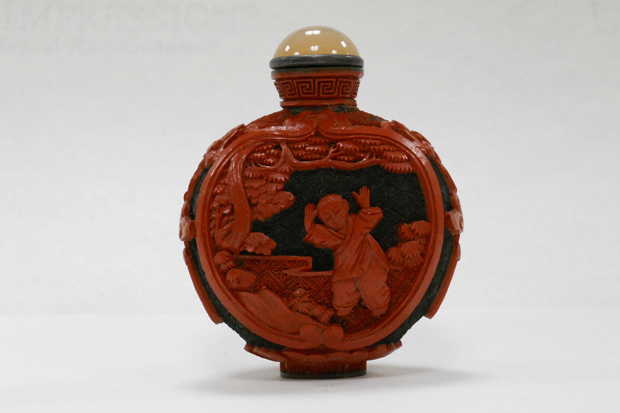Snuff bottle collection offers views into the Qing
Bottles from the 18th and 19th century housed in the Robert D. Farber University Archives & Special Collections Department
From 18th-century villages in China, to 415 South St. in Waltham, a collection of 47 snuff boxes are tucked away inside the Robert D. Farber University Archives & Special Collections Department awaiting viewers. Manhattan attorney Jack J. Katz and his wife Therese donated the unusual collection, which can be seen by appointment, to the university in 1964.Snuff, a powdered form of tobacco that is inhaled, became popular during the Qing Dynasty. While smoking was forbidden, snuff was allowed. In fact, it was said that snuff aided in alleviating headaches, gastrointestinal problems and the common cold and soon became part of socializing.
Many snuff bottles were utilitarian, small enough to fit into a purse or pocket, and complete with a self-contained spoon with which to remove and use the snuff. But as time went on, designs became more elaborate and included materials such as semi-precious stones, porcelain, metal, ivory, wood, lacquer, cinnabar and mother of pearl.
“Very few objects so elegantly display the variety of decorative materials used in old China,” says Aida Yuen Wong, chair of the East Asian studies and associate professor of art history. “They epitomize Chinese ingenuity in miniature craftsmanship and are truly art that can be held in one's hand.”
The Jack J. and Therese G. Katz Snuff Bottle Collection contains a wide variety of shapes, textures and materials.
“The beautiful designs and ornate decorations painted on and carved into the snuff bottles partly accounts for their popularity and collectability,” says Alex Wagner Lough, archives and special collections assistant and Ph.D. candidate in history. “After 1882, a highly-skilled technique called 'inside painting' became popular.”
Because the bottles are so small, only the most skilled artists took part and became highly specialized.
“Ma Shaoxuan was certainly one of the most renowned, says Wong. “Among the connoisseurs today, he is nicknamed the 'Picasso of inside-painted bottles'."
Due to the artisanship and materials, snuff bottles soon became objects of status and were given as gifts.
“Having a snuff bottle was a sign of prestige,” says Xing Hang, assistant professor of history. “The bottle soon took on a significance of its own, away from what it carried and became an art form. Some designs came from ancient Confucian moral tales or Buddhist allegories.”
Though popularity of snuff fell soon after the Republic of China was established, collectors and admirers continue to marvel at the bottles.
Wong says that with the 1960s publication of Lilla Perry's “Chinese Snuff Bottles: The Adventures & Studies of a Collector,” this class of objects caught international attention.
“Today, good quality works are increasingly difficult to get and can cost hundreds of thousands,” says Wong. “We are very fortunate to house such a large and exquisite collection at Brandeis.”
To view the snuff bottle collection, contact Sarah Shoemaker.
Categories: Arts, Humanities and Social Sciences







